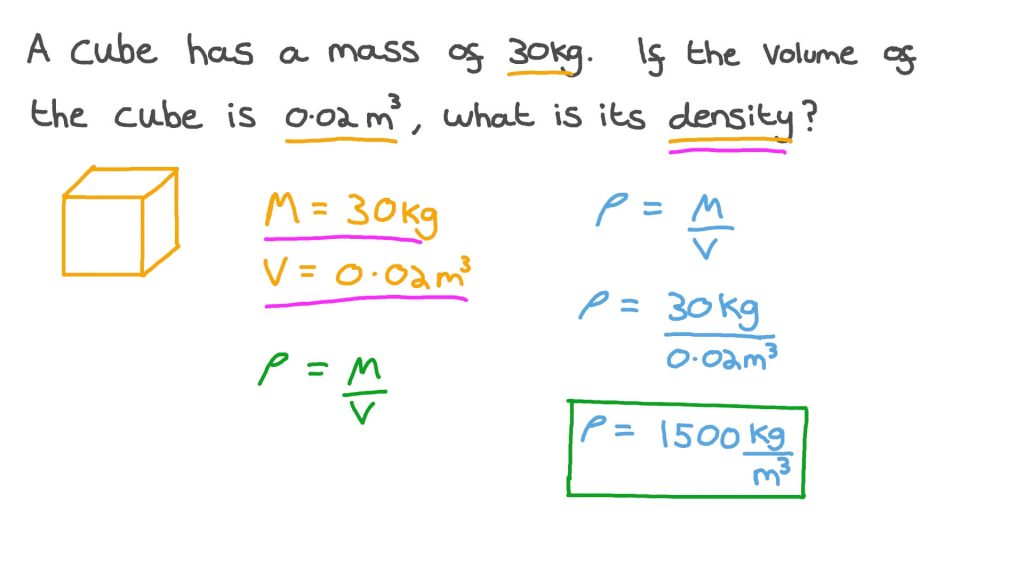Did you know that understanding the density of an object can provide valuable insights into its composition and properties? If you’ve ever wondered how to find the density of a cube, look no further.
In this discussion, we will demystify the concept of density and guide you through the process of calculating it for a cube.
Whether you’re a student studying physics or simply have a curious mind, knowing how to determine the density of a cube can open up a world of knowledge and understanding.
So, let’s dive in and uncover the secrets behind this fundamental concept in physics.
Understanding Density and Its Importance
Understanding density and its importance is crucial in many scientific fields, as it helps determine the amount of mass packed into a given volume. Density is defined as the measure of how much mass is contained within a specific volume of an object or substance. It’s calculated by dividing the mass of an object by its volume. By understanding density, scientists can gain valuable insights into the properties and behavior of different materials.
Density plays a vital role in various scientific disciplines, including physics, chemistry, and geology. In physics, density is used to describe the compactness of matter and is an essential factor in determining the buoyancy of objects. In chemistry, density helps identify and distinguish between different substances, as each material has its unique density value. Geologists use density to study and classify rocks, minerals, and even entire planets.
Moreover, understanding density allows scientists to make predictions about the behavior of materials under different conditions. For example, knowing the density of a substance can help determine whether it will float or sink in a liquid. This information isn’t only useful for scientists but also has practical applications in various industries, such as manufacturing, construction, and engineering.
Definition of a Cube and Its Properties
A cube is a three-dimensional geometric shape with six equal square faces. Each face of a cube is identical in size and shape, and all the angles between the faces are right angles. The cube is a regular polyhedron, meaning that all its edges have the same length. In addition to having six faces, a cube also has eight vertices and twelve edges.
The equal sides and angles of a cube make it a highly symmetrical shape. This symmetry is what distinguishes a cube from other three-dimensional shapes. Due to its symmetrical nature, a cube can be easily manipulated and studied mathematically.
One interesting property of a cube is that all its diagonals are equal in length. A diagonal of a cube connects two non-adjacent vertices and passes through the center of the cube. This property is important when calculating the length or distance between two points within a cube.
Another useful property of a cube is that its volume can be determined by simply cubing the length of one of its sides. The volume of a cube is given by the formula V = s^3, where V represents the volume and s represents the length of a side.
Understanding the properties of a cube is crucial for various fields, including mathematics, physics, and engineering. Its simplicity and symmetry make it a fundamental shape to study and analyze.
Formula for Calculating Density
To calculate the density of an object, you need to divide its mass by its volume. Density is a measure of how much mass is packed into a given volume. It tells us how tightly the particles are packed together within an object.
The formula for calculating density is straightforward: Density = Mass / Volume. In this equation, the mass is measured in grams (g) or kilograms (kg), and the volume is measured in cubic centimeters (cm³) or cubic meters (m³).
Let’s say you have a cube with a mass of 500 grams and a volume of 100 cubic centimeters. To find its density, simply divide the mass (500 g) by the volume (100 cm³). The result will be the density of the cube, expressed in grams per cubic centimeter (g/cm³).
Understanding the formula for calculating density is crucial in various fields of science, such as physics and chemistry. It enables us to characterize and compare different materials and substances based on their physical properties. By calculating density, scientists can determine if an object will float or sink in a particular liquid, or even identify unknown substances based on their density values.
Gathering the Required Measurements
To gather the required measurements for calculating the density of a cube, you need to measure its dimensions and calculate its mass.
Start by measuring the length, width, and height of the cube using a ruler or tape measure.
Next, determine the mass of the cube by using a scale or balance.
These measurements will provide the necessary data to calculate the density of the cube.
Measuring the Cube’s Dimensions
You can gather the required measurements for the cube’s dimensions by using a ruler or measuring tape.
To measure the length, simply place one end of the ruler or tape measure at one side of the cube and extend it to the opposite side. Make sure to align the ruler or tape measure with the edges of the cube for an accurate measurement.
Repeat this process for the width and height of the cube. Be careful to measure from edge to edge, ensuring that you capture the full dimensions of the cube.
Take note of your measurements in either centimeters or inches, as these are commonly used units for measuring dimensions.
Calculating the Cube’s Mass
After measuring the dimensions of the cube, the next step is to gather the necessary measurements to calculate its mass.
To determine the mass of the cube, you’ll need to measure its weight using a scale. Place the cube on the scale and record the reading. Ensure that the scale is calibrated properly for accurate results.
It’s important to note that the weight of the cube isn’t the same as its mass, as weight is affected by gravitational force. However, for practical purposes, we can assume that the weight and mass are equivalent for objects on Earth’s surface.
Determining the Mass of the Cube
First, measure the mass of the cube using a balance or scale. This step is crucial in determining the density of the cube accurately. To begin, place the cube carefully on the balance or scale, ensuring that it’s centered and stable. Make sure the scale is properly calibrated before proceeding.
Gently and steadily lower the cube onto the scale, taking care not to apply any unnecessary force that could cause inaccuracies in the measurement. Once the cube is resting on the scale, allow it to settle and stabilize for a few moments. Read the mass measurement displayed on the scale, taking note of the units used. It’s important to record the mass accurately, avoiding any rounding errors or approximations. If necessary, repeat the process to ensure precision.
Remember to subtract the mass of the container or any other objects used to hold the cube during measurement, as this would affect the final mass value. With the mass of the cube now determined, you’re one step closer to calculating its density.
Measuring the Volume of the Cube
To measure the volume of the cube, you’ll need to determine the length of one side. The volume of a cube is calculated by raising the length of one side to the power of three. So, if the length of one side is represented by the variable ‘s,’ the volume of the cube would be s cubed, or s^3.
To find the length of one side, you can use a ruler or a measuring tape. Place the ruler or measuring tape along one edge of the cube and read the measurement in either inches or centimeters. Make sure to measure from one end of the side to the other, taking into account the entire length.
Once you have determined the length of one side, you can then calculate the volume of the cube by raising that measurement to the power of three. This will give you the total amount of space inside the cube. Remember to include the unit of measurement in your final answer, such as cubic inches or cubic centimeters.
Applying the Density Formula
Now that you understand how to measure the volume of the cube, let’s move on to applying the density formula.
The density formula is a simple equation that allows you to calculate the density of an object, including a cube.
Density Formula Explained
You can apply the density formula to determine the density of an object. The density formula is expressed as density equals mass divided by volume.
To apply this formula, you need to know the mass of the object, which can be measured using a scale, and the volume of the object, which can be calculated by measuring its dimensions.
Once you have these values, simply divide the mass by the volume to obtain the density. The density is typically measured in units such as grams per cubic centimeter or kilograms per cubic meter.
Understanding the density formula allows you to determine the density of any object, which can be useful in various scientific and practical applications.
Calculating Cube Density
Calculating the density of a cube is a straightforward process that involves applying the density formula. To calculate the density, you need to know the mass and volume of the cube.
First, measure the mass of the cube using a scale. Make sure to record the mass in units of grams.
Next, measure the length of one side of the cube to find its volume. Since a cube has all sides equal, the volume is obtained by cubing the length of one side.
Now that you have the mass and volume, you can apply the density formula: density = mass/volume. Simply divide the mass by the volume to find the density of the cube.
Remember to include the appropriate units in your final answer, typically grams per cubic centimeter (g/cm³).
Interpreting the Results
To properly understand the significance of the density measurements, it’s important to carefully interpret the results obtained from calculating the density of a cube. The density of an object represents its mass per unit volume. When you calculate the density of a cube, you’re determining how much mass is packed into a given volume. This information can provide insights into the composition and properties of the cube.
Interpreting the results involves analyzing the value obtained for the density. A high density indicates that the cube is composed of a denser material, such as lead or iron. On the other hand, a low density suggests that the cube is made of a less dense material, like wood or plastic. By comparing the calculated density to known densities of different substances, you can make educated guesses about the material the cube is made of.
Additionally, interpreting the results can also involve considering the precision and accuracy of your measurements. Any errors or uncertainties in the measurements can affect the accuracy of the calculated density. Therefore, it’s crucial to assess the reliability of your measurements and take them into account when interpreting the results.
Factors Affecting the Density of a Cube
When considering the factors affecting the density of a cube, there are several key points to keep in mind.
First, the material composition of the cube has a significant impact on its density.
Secondly, varying the size of the cube can also affect its density, with larger cubes typically having a lower density.
Lastly, temperature and pressure can influence the density of a cube, as changes in these factors can cause the molecules to become more or less tightly packed.
Material Composition Impact
The material composition of a cube directly impacts its density. The density of a cube is determined by the mass of the cube and the volume it occupies.
Different materials have different densities due to their atomic and molecular structures. For example, a cube made of lead will be denser than a cube made of aluminum, even if they’ve the same dimensions. This is because lead is a denser material than aluminum.
The arrangement and size of atoms or molecules in a substance influence its density. Materials with tightly packed atoms or molecules will have a higher density, while those with loosely packed particles will have a lower density.
Therefore, when calculating the density of a cube, it’s important to consider the material from which it’s made.
Cube Size Variation
Cube size variation affects the density of a cube due to the relationship between volume and mass. When the size of a cube increases, its volume also increases, assuming the shape remains the same. Since density is calculated by dividing mass by volume, an increase in volume with a constant mass leads to a decrease in density.
Conversely, when the size of a cube decreases, its volume decreases. With a constant mass, this decrease in volume results in an increase in density. Therefore, the size of a cube directly influences its density.
It’s important to consider the dimensions of a cube when calculating its density, as a change in size can significantly impact the final density value.
Temperature and Pressure
To understand how temperature and pressure affect the density of a cube, it’s important to consider their influence on the volume and mass of the cube.
Temperature refers to the average kinetic energy of the particles in a substance, while pressure is the force applied per unit area. When temperature increases, the particles in the cube gain more energy and move faster, causing the substance to expand and the volume to increase. This leads to a decrease in density.
On the other hand, when pressure increases, the particles in the cube are compressed, reducing the volume and increasing the density. Therefore, as temperature increases, the density of a cube decreases, while an increase in pressure leads to an increase in density.
These factors play a crucial role in determining the density of a cube.
Real-Life Applications of Cube Density
Understanding the density of a cube can provide valuable insights into various real-life scenarios. One practical application of cube density is in construction. By knowing the density of different building materials, engineers can select the appropriate materials for different parts of a structure. For example, if a building needs a strong foundation, materials with higher density, such as concrete, may be used. On the other hand, for structures that require lightweight materials, lower density substances like foam or certain types of wood may be more suitable.
Another real-life application is in the field of geology. Geologists use the concept of density to identify and classify different types of rocks and minerals. By measuring the density of a rock sample, scientists can determine its composition and properties, which helps in understanding the Earth’s geological history and even in locating valuable mineral deposits.
Cube density is also relevant in the food industry. By knowing the density of different ingredients, such as sugar or flour, manufacturers can accurately measure and control the quantities used in recipes. This ensures consistent product quality and taste.
Frequently Asked Questions
Can the Density of a Cube Change if Its Shape or Size Is Altered?
Yes, the density of a cube can change if its shape or size is altered. Density is calculated by dividing the mass of an object by its volume, so any changes in shape or size will affect the volume and therefore the density.
How Does the Density of a Cube Affect Its Buoyancy in Different Fluids?
The density of a cube affects its buoyancy in different fluids because buoyancy depends on the relative density between the cube and the fluid. If the cube is less dense than the fluid, it will float. If it is more dense, it will sink.
Can the Density of a Cube Be Negative?
No, the density of a cube cannot be negative. Density is a measure of how much mass is packed into a given volume, so it is always a positive value.
Are There Any Practical Limitations to Accurately Measuring the Volume of a Cube?
To accurately measure the volume of a cube, ensure you have precise measuring instruments and take multiple measurements for accuracy. Also, consider any irregularities or imperfections in the cube’s shape that may affect the measurement.
How Can the Density of a Cube Be Used to Determine Its Material Composition?
To determine the material composition of a cube, you can use its density. Density is calculated by dividing the mass of the cube by its volume. Different materials have different densities, allowing for identification.
Conclusion
So in conclusion, finding the density of a cube is a simple process that involves calculating the mass and volume of the cube.
By using the formula for density, you can determine the density of the cube and understand its physical properties.
Density is an important concept in physics and has numerous real-life applications.
By understanding density, we can better understand the behavior and characteristics of various objects and materials.


